Themed collection Radical Chemistry

Copper-catalyzed radical relay in C(sp3)–H functionalization
In this review, we summarize the recent advances in the field of copper-catalyzed C–H functionalization via a radical relay process, with a critical focus on the asymmetrical versions.

Chem. Soc. Rev., 2022,51, 1640-1658
https://doi.org/10.1039/D1CS00727K
Boron, silicon, nitrogen and sulfur-based contemporary precursors for the generation of alkyl radicals by single electron transfer and their synthetic utilization
Recent developments in the use of boron, silicon, nitrogen and sulfur derivatives in single-electron transfer reactions for the generation of alkyl radicals are described.
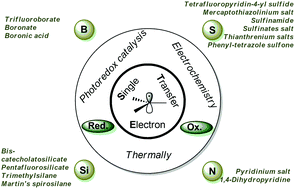
Chem. Soc. Rev., 2022,51, 1470-1510
https://doi.org/10.1039/D1CS01084K
Recent advances in transition-metal-catalysed asymmetric coupling reactions with light intervention
The advances on transition-metal catalysed asymmetric couplings with light intervention in recent years was summarized in this review. In order to better meet the needs of modern chemistry, further research outlook was also proposed.
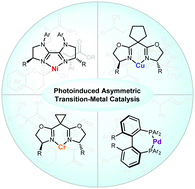
Chem. Soc. Rev., 2021,50, 12808-12827
https://doi.org/10.1039/D1CS00210D
Catalytic three-component dicarbofunctionalization reactions involving radical capture by nickel
In this review, we summarize the recent advances in the area of catalytic dicarbofunctionalization of unsaturated π bonds by underpinning the catalytic domino transformations involving radical capture by nickel.
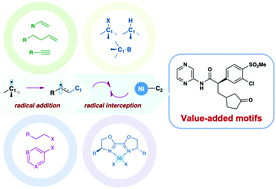
Chem. Soc. Rev., 2021,50, 10836-10856
https://doi.org/10.1039/D1CS00399B
Cysteinyl radicals in chemical synthesis and in nature
An overview of the unique reactivity of cysteinyl radical intermediates in both chemical synthesis and biological systems is provided, with a critical focus on mechanistic details.
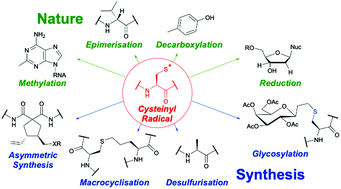
Chem. Soc. Rev., 2021,50, 10857-10894
https://doi.org/10.1039/D1CS00254F
Recent advances in visible light-activated radical coupling reactions triggered by (i) ruthenium, (ii) iridium and (iii) organic photoredox agents
Visible light-activated reactions continue to expand and diversify. The example shown here is a Birch reduction achieved by organophotoredox reagents.

Chem. Soc. Rev., 2021,50, 9540-9685
https://doi.org/10.1039/D1CS00311A
Advances in chemistry of N-heterocyclic carbene boryl radicals
This review focuses on synthesis and reactions of boryl radicals ligated by N-heterocyclic carbenes.
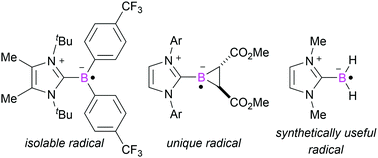
Chem. Soc. Rev., 2021,50, 8995-9021
https://doi.org/10.1039/D1CS00385B
Molecular oxygen-mediated oxygenation reactions involving radicals
Molecular oxygen as a green, inexpensive oxidant and oxygen source has displayed lots of advantages compared to other oxidants. This review introduces the recent advances of radical processes in molecular oxygen-mediated oxygenation reactions.

Chem. Soc. Rev., 2021,50, 8067-8101
https://doi.org/10.1039/D1CS00242B
Electrocatalysis as an enabling technology for organic synthesis
Electrochemistry has recently gained increased attention as a versatile strategy for achieving challenging transformations at the forefront of synthetic organic chemistry.

Chem. Soc. Rev., 2021,50, 7941-8002
https://doi.org/10.1039/D1CS00223F
Photochemical radical cyclization reactions with imines, hydrazones, oximes and related compounds
Photochemical reactions of imines, hydrazones, oximes and related compounds provides an efficient access to radical intermediates in the synthesis of heterocycles.
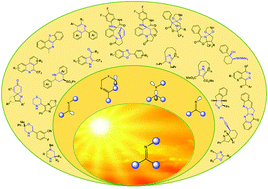
Chem. Soc. Rev., 2021,50, 7418-7435
https://doi.org/10.1039/D1CS00196E
Dissociations of free radicals to generate protons, electrophiles or nucleophiles: role in DNA strand breaks
The concept behind the research described in this article was that of marrying the ‘soft’ methods of radical generation with the effectiveness and flexibility of nucleophile/electrophile synthetic procedures.
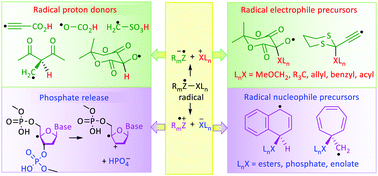
Chem. Soc. Rev., 2021,50, 7496-7512
https://doi.org/10.1039/D1CS00193K
Radical photoinitiation with LEDs and applications in the 3D printing of composites
Radical initiation upon LED light irradiation is discussed herein as well as its application in additive manufacturing.
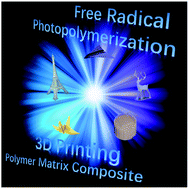
Chem. Soc. Rev., 2021,50, 3824-3841
https://doi.org/10.1039/D0CS01411G
Recent advances in electrochemical oxidative cross-coupling with hydrogen evolution involving radicals
This tutorial review provides an overview of the most recent developments in electrochemical oxidative cross-coupling with hydrogen evolution involving radicals.
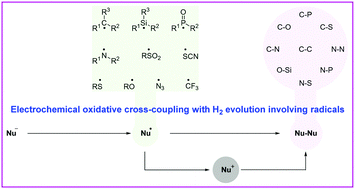
Chem. Soc. Rev., 2021,50, 10058-10086
https://doi.org/10.1039/D1CS00150G
Evolution towards green radical generation in total synthesis
This tutorial review outlines the evolution of methods for radical generation with applications in total synthesis, starting from classical methods towards greener methods that utilize recent advances in electrochemistry and photoredox catalysis.

Chem. Soc. Rev., 2021,50, 10044-10057
https://doi.org/10.1039/D1CS00411E
Recent advances in the direct construction of enantioenriched stereocenters through addition of radicals to internal alkenes
This review highlights the recent significant progress in the realm of rapidly and conveniently building enantioenriched stereocenters via addition of radicals to internal alkenes.
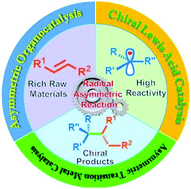
Chem. Soc. Rev., 2021,50, 8857-8873
https://doi.org/10.1039/D1CS00208B
Autoxidation vs. antioxidants – the fight for forever
Autoxidation limits the longevity of essentially all hydrocarbons and materials made therefrom – including us.
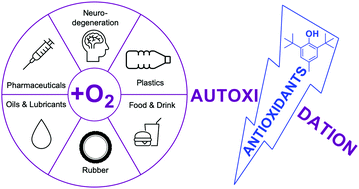
Chem. Soc. Rev., 2021,50, 7343-7358
https://doi.org/10.1039/D1CS00265A
Radical trifluoromethylation
Radical trifluoromethylation has been emerging as a versatile tool for the synthesis of trifluoromethylated compounds that play increasingly important roles in pharmaceuticals, agrochemicals and materials science.
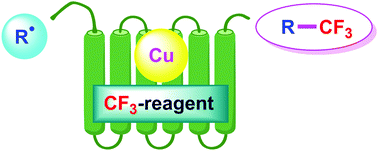
Chem. Soc. Rev., 2021,50, 6308-6319
https://doi.org/10.1039/D1CS00200G
About this collection
The themed collection, Guest Edited by Xin-Yuan Liu (Southern University of Science and Technology) and John Walton (University of St. Andrews) is intended to inform readers on the latest advances in synthetic and mechanistic radical chemistry. A wide range of topics is envisaged including novel assembly and ring closure processes with carbon- and heteroatom-centred species. The collection will feature the hot area of radical catalytic processes, particularly single electron transfers and photoredox organocatalysed processes. The upsurge of interest in the role of metals in radical catalytic systems, especially with reference to stereocontrol, will be catered for. Innovative reagents will be introduced for the generation of radicals and their employment in functional group manipulations. Advances in the understanding of radical mediated oxidations and new antioxidants will also be incorporated.